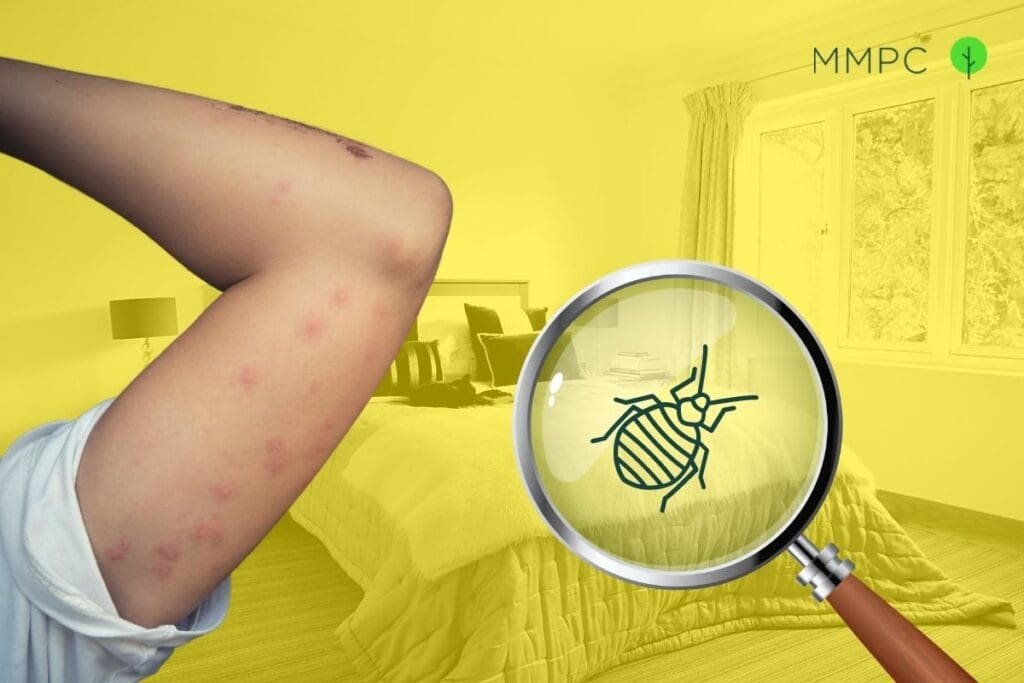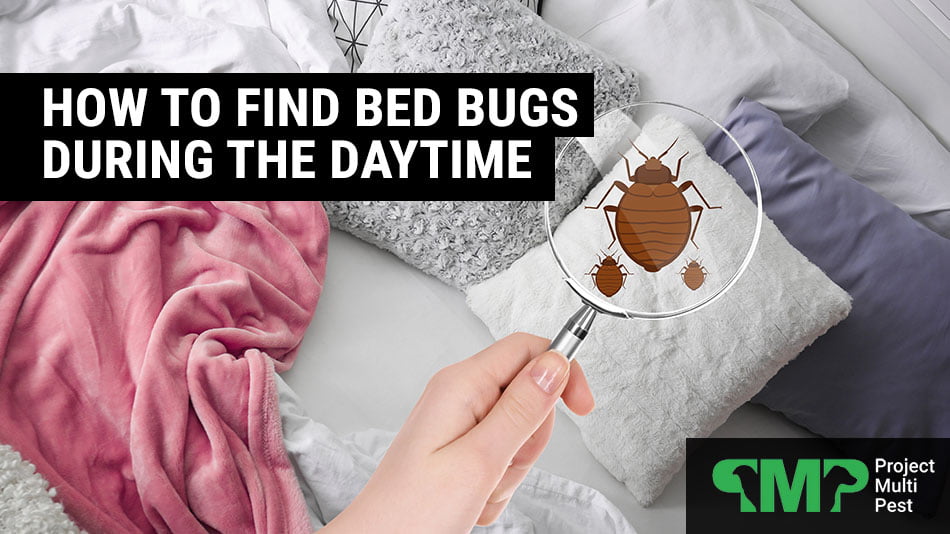To find bed bugs during the day, look for blood stains, feces, and shed skins on the mattress, bed frame, and other furniture. It is nearly impossible to find live bed bugs during the day because they tend to hide once they have fed.
However, these signs are an indication of a possible bed bug infestation. Bed bugs are pesky insects that can cause discomfort and anxiety, but finding them early can help prevent a larger infestation. Taking the time to inspect your home for these signs can help you find bed bugs before they become a bigger problem.
We will discuss some tips for finding bed bugs during the day and what to do if you discover an infestation.

Credit: www.wikihow.life
Inspecting Potential Harborage Sites
To find bed bugs during the day, it’s important to inspect all potential harborage sites where they might be hiding. Look for bed bugs in the seams of chairs and couches, between cushions, in electrical receptacles and appliances, and under loose wall paper and wall hangings.
Use a steamer or a hairdryer to heat areas like mattresses to lure them out.
If you suspect bed bugs are lurking in your home, it’s important to be thorough in your search. These pesky critters can be tricky to spot during the day, but they leave behind clues that can help you detect an infestation. One of the most important steps in finding bed bugs during the day is inspecting potential harborage sites. Here’s how to do it.Inspect Your Bed
Your bed is a prime location for bed bugs to set up camp. Start by inspecting your mattress and bedding for any signs of bed bug activity. Look for tiny blood spots, shed skins, and live bugs. Be sure to also check between the mattress and box spring, as well as the bed frame and headboard.Inspect The Box Spring
The box spring is another common hiding spot for bed bugs. Carefully inspect the seams and corners, lifting up any dust cover to check for bed bug activity. Use a flashlight to help you see into the crevices.Inspect Other Furniture
Bed bugs can hide in other pieces of furniture besides your bed. Check sofas, chairs, and other upholstered furniture for signs of bed bug activity. Don’t forget to also inspect any drawers or shelves in the room. Pay close attention to any cracks or crevices where bed bugs like to hide.Remember, detecting a bed bug infestation during the day requires a detailed and thorough inspection of all potential harborage sites. If you do find evidence of bed bugs, it’s important to take action right away to prevent the problem from spreading.
Credit: bedbugsos.ca
Bugs That Look Like Bed Bugs
While bed bugs typically hide during the day, you can still spot them by looking for signs of their presence. One way to differentiate them from bugs that look like bed bugs, such as fleas and skin beetles, is to inspect their harborage sites.
These include seams of mattresses and furniture, electrical receptacles, and drawer joints. Using a steamer or keeping an eye out at night can also draw them out.
Introduction: Bugs That Look Like Bed BugsBed bugs are known to be elusive and often only emerge during the night to feed on their hosts. If you suspect a bed bug infestation, chances are you won’t see them during the day. However, there are bugs that look like bed bugs that you may encounter in broad daylight. Identifying these pests is key to preventing a full-blown infestation. In this article, we’ll take a look at some of the common bugs that look like bed bugs, including fleas, skin beetles, bat bugs, booklice, spider beetles, and ticks.FleaFleas are small, wingless insects that feed on the blood of warm-blooded animals, including humans. They are often mistaken for bed bugs due to their similar appearance. Fleas are typically dark brown in color and have a flattened, narrow body. They are about 1/8 inch long and have six legs that are adapted for jumping. Flea bites are also similar to bed bug bites, causing red and itchy welts. However, flea bites are often concentrated around the ankles and lower legs, while bed bug bites tend to occur in clusters on the upper body.Skin BeetlesSkin beetles are tiny insects that are often confused with bed bugs due to their similar size and shape. They are typically brown or black in color and have a hard exoskeleton. Skin beetles are known to feed on dead skin and hair, which can make them a nuisance in homes. However, unlike bed bugs, skin beetles do not bite humans and are not known to transmit diseases.Bat BugBat bugs are closely related to bed bugs and are often found in colonies around bat roosts. They are similar in appearance to bed bugs but have longer hairs on their bodies. Bat bugs are often carried into human homes on clothing or in luggage and can quickly establish a new infestation. Like bed bugs, bat bugs feed on the blood of humans and can cause itchy bites.BookliceBooklice are small, wingless insects that are often found in damp areas of homes, such as basements and bathrooms. They are light brown or cream-colored and have a soft body. While they are not known to bite humans, booklice can cause damage to paper and books. Unlike bed bugs, booklice do not feed on blood and are not known to transmit diseases.Spider BeetleSpider beetles are small, oval-shaped insects that are often found in stored food products, such as rice and flour. They are reddish-brown in color and have long, thin legs. While spider beetles do not bite humans, they can contaminate food and should be eliminated as soon as they are discovered. Spider beetles are often mistaken for bed bugs due to their similar shape and size.TickTicks are a common outdoor pest that are often brought into homes on pets. They are brown or black in color and have flat, round bodies. While ticks are known to feed on the blood of animals and humans, they are usually found crawling on the skin rather than biting. Ticks are often larger than bed bugs and can be easily identified by their eight legs.In conclusion, while bed bugs may lurk only in darkness, there are common bugs that look like them that can be found during the day. Identifying these pests is crucial to preventing an infestation and avoiding unnecessary treatments. By knowing the differences between bed bugs and similar-looking pests, you can take the necessary steps to protect your home and family.
Credit: mandmpestcontrol.com
Frequently Asked Questions For How To Find Bed Bugs During The Day?
How Do You Draw Bed Bugs Out Of Hiding?
To draw bed bugs out of hiding, you can use a steamer or hairdryer to heat areas such as mattresses to trick them into thinking a human host is near. You can also look for signs such as blood stains, feces, and shed skins visible on the mattress, bed frame, and other furniture.
Spotting their nests at night when they are most active is also effective.
How Do You Find A Bed Bug Nest?
To find a bed bug nest, inspect all potential harborage sites including your bed, box spring and other furniture. Look for indicators such as blood stains, faeces and shed skins that may be visible on the surface. Bed bugs hide once they have fed, so it’s almost impossible to find live bed bugs during the day.
Use a steamer or a hairdryer to heat areas around the bed to lure them out of hiding spots. Alternatively, you can keep an eye out at night when bed bugs are most active to locate their nests.
How Do You Get Rid Of Bed Bugs During The Day?
Bed bugs are elusive during the day, but you can still find evidence such as blood stains, feces, and shed skins on the mattress, bed frame, and other furniture. To lure them out of hiding, you can use a steamer or hairdryer to heat mattresses or keep an eye out at night when they are most active.
Do I Have Bed Bugs If I Can’t See Them?
Bed bugs are difficult to spot as they tend to hide during the day. Look for signs such as bloodstains, feces, and shed skins on the mattress, bed frame, and other furniture to confirm if you have them. If you wake up with itchy bites that weren’t there before, it could also indicate a bedbug issue.
Conclusion
To sum up, finding bed bugs during the day can be a challenging task, but it is not impossible. By inspecting all the potential harborage sites, especially the mattress, box spring, and other furniture, you can easily detect the presence of bed bugs.
Additionally, keeping a lookout at night can help locate their nests when they are most active. Remember to look for any signs of blood stains, feces, or shed skins that may be visible on the mattress, bed frame, and other furniture.
By following these steps, you can keep your home free from bed bugs and enjoy a good night’s sleep.
Related posts:

I’m MD Tanvir, and I bring years of expertise gained from working closely with pest control companies to the forefront. My journey in the industry has inspired me to launch Bug Battler, a platform aimed at equipping people with the know-how to combat pests autonomously. Through Bug Battler, I aim to empower individuals with practical insights to tackle pest infestations effectively.

